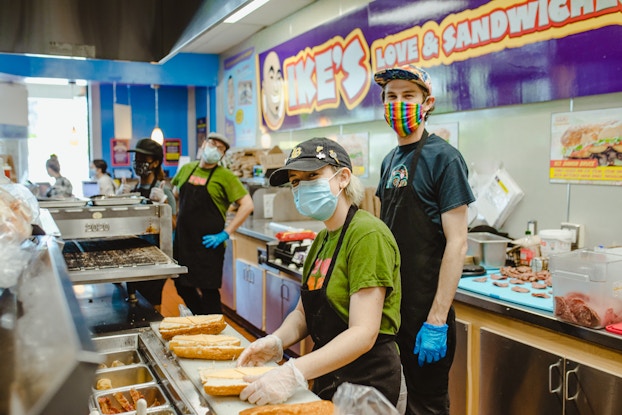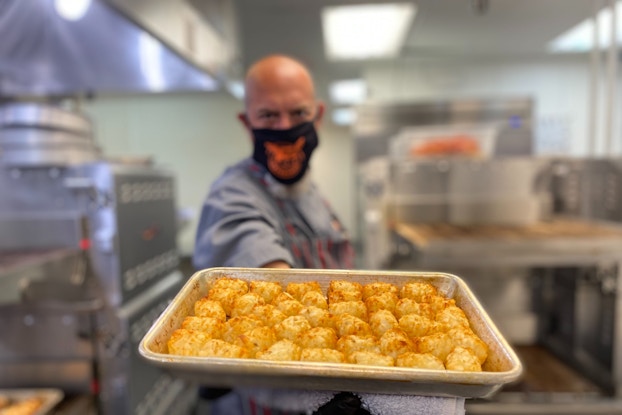
Why it matters:
- The U.S. restaurant industry, which still employs an estimated one million fewer workers than before the pandemic, is pivoting to bounce back after a devastating 2020.
- Labor-saving efficiencies such as digital ordering and improved processes are helping restaurants get by with a reduced workforce.
- Restaurants are competing for labor by offering improved work environments and corporate culture.
Restaurant companies are coping with a labor shortage that is forcing the industry to rethink its longstanding operating models.
Many foodservice businesses are striving to retain some of the labor efficiencies that they implemented during the pandemic, such as encouraging customers to use digital ordering and digital payment, which allow restaurants to operate with fewer staff. Some are also reducing hours and streamlining their operations in other ways in an effort to get by with fewer employees.

Interested in a small business membership?
Find out how the U.S. Chamber of Commerce can help your company grow and thrive in today's rapidly-evolving business environment. Connect with our team to learn how a small business membership can benefit your bottom line and help you achieve your goals.
Amid rising wage pressures, many restaurants are also leaning into quality-of-life benefits for employees, from evenings off to a no-uniform policy, as a selling point for their businesses to be viewed as attractive workplaces.
At sandwich chain Ike’s Love & Sandwiches, the company found that customers have continued to order online and via mobile app even as restrictions on indoor dining started to loosen, which has been a help in operating with fewer workers per store during the labor crunch.
“We found we were able to capture a lot of those customers and keep them on the digital side, even when they were coming in to eat,” Michael Goldberg, CEO of Ike’s, told CO—. “They would order in advance on the app and dine in, which has helped in terms of the number of people we have on staff. Instead of needing two or three cashiers at any one time, we can get away with one or two.”
Many restaurants, like businesses in other industries, have reported that they have been struggling to find workers, as many have left the industry for new opportunities during the pandemic and others remain fearful of the ongoing spread of COVID-19.
The U.S. restaurant industry is one million jobs short of its pre-pandemic employment level of 12.3 million, according to the National Restaurant Association.
“The labor shortage continues to plague the industry, and we don’t see industry employment returning to full strength until well into 2022,” said Hudson Riehle, senior vice president of research and knowledge at the NRA.
[Read here on five restaurant industry pandemic pivots.]
At sandwich chain Ike’s Love & Sandwiches, the company found that customers have continued to order online and via mobile app even as restrictions on indoor dining started to loosen, which has been a help in operating with fewer workers per store during the labor crunch.
Inklings of a restaurant rebound
The association’s tracking survey found that 75% of restaurant operators claim recruitment is their biggest challenge.
Employment in the industry has been rebounding in the last few months, however. The Bureau of Labor Statistics reported an increase of 253,200 jobs at eating and drinking places on a seasonally adjusted basis for the month of July.
During the first seven months of 2021, eating and drinking places added a net 1.3 million jobs.
Several chain restaurant operators, including McDonald’s and Chipotle, have announced wage increases, which some observers have cited as the solution to the problem. That in turn, combined with increases in product cost inflation, will likely lead to menu price increases, some restaurant operators said.
“There are a lot of external pressures on the industry to raise prices,” said Goldberg, although he said Ike’s had not yet done so.

Making process improvements by streamlining operations
In addition to leveraging customers’ shift toward digital ordering and payment, operators have also found other ways to streamline their operations and processes to minimize the staffing levels needed to operate their restaurants, said Kelly Roddy, CEO of WOWorks, parent of the Saladworks, Frutta Bowls and Garbanzo Mediterranean Fresh chains.
“It forces us to look at process, and it actually makes us improve,” he said. “That increases productivity, in part because you just have to.”
Some restaurants have reduced their hours of operation in order to function with reduced staffing levels, including some WOWorks locations, Roddy said.
“Instead of opening at 9 or 10 in the morning until 10 or 11 at night, we may open at 10:30 in the morning and close at 7:30 or 8 in some instances, just because of staffing,” he said.
Speaking of the industry in general, Roddy said some restaurants will likely have reconfigured their operations and adopted technologies such as kiosk- and app-based ordering, to the degree that they will never return to previous employment levels.
A restaurant that once required 30 people to operate, for example, might now operate at the same level with five fewer workers.
For example, at WOWorks, about a third of orders are now placed digitally, he said, compared with 5% just a few years ago.
“We have spent a lot of time making that technology better and making it faster, and that has helped a lot,” he said.
The increase in digital orders has also helped improve in-store customer service, he said, by enabling store workers to focus more attention on the customers that are inside the stores.
Cluster Truck, a technology-driven, delivery-only restaurant company with several locations in the Midwest, has also streamlined its operations, said Brian Howenstein, chief operating officer.
The company, which allows customers to combine items from multiple menus and cuisines in a single delivery order, reorganized its cooking line so that fewer cooks would be needed, which has helped it operate more efficiently, he said.
“I think restaurants are going to have to figure out if they can get by with fewer workers who are more highly paid, versus more workers who may not be as highly paid,” said Howenstein.
[Read here on businesses pivoting to touchless technology.]

Creating a desirable work environment
Cluster Truck has been able to attract and retain workers in part by creating a desirable work environment, he said.
As a delivery-only restaurant that takes orders digitally, the company’s line cooks have the luxury of being able to focus on cooking in relatively quiet kitchens where orders are processed without having to coordinate with waitstaff or on-site diners, Howenstein explained.
“I think we are reaping the benefits of the fact that we are a desirable employer to work for,” he said.
Likewise, Ike’s Love & Sandwiches benefits from a strong company culture and the fact that its restaurants close relatively early, allowing workers to have most of their evenings free, said Goldberg. Employees also do not have to wear uniforms, and the company seeks to provide a “fun atmosphere” for its workers.
“Some places are harder than others [to find labor], but overall, we’re in pretty good shape at our restaurants,” he said. “When people come in for that first interview and they get that first take on the concept, they feel comfortable coming to work for us.”
WOWorks also has been focused on ensuring that it is providing a good working environment for its store-level staff, said Roddy.
“I think at the end of the day, if you have a good culture and you treat people well, people will want to work where they feel valued,” he said. “We have not struggled that much with staffing, because we really doubled down on these things. We have talked about it every day, and [I] think that’s made a big difference.”
CO— aims to bring you inspiration from leading respected experts. However, before making any business decision, you should consult a professional who can advise you based on your individual situation.
Follow us on Instagram for more expert tips & business owners’ stories.
CO—is committed to helping you start, run and grow your small business. Learn more about the benefits of small business membership in the U.S. Chamber of Commerce, here.







